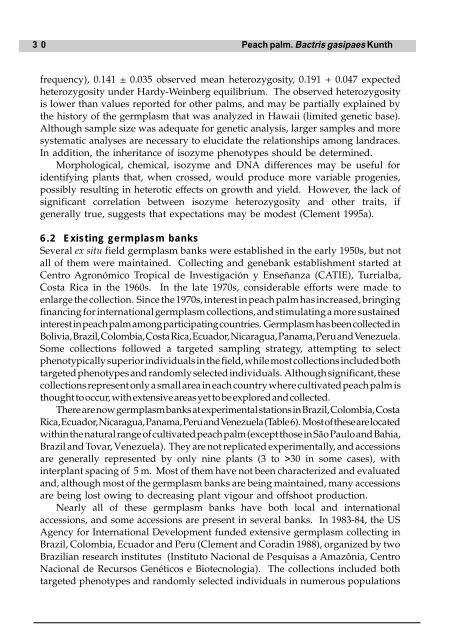Peach palm - World Agroforestry Centre
Peach palm - World Agroforestry Centre
Peach palm - World Agroforestry Centre
You also want an ePaper? Increase the reach of your titles
YUMPU automatically turns print PDFs into web optimized ePapers that Google loves.
3 0 <strong>Peach</strong> <strong>palm</strong>. Bactris gasipaes Kunth<br />
frequency), 0.141 ± 0.035 observed mean heterozygosity, 0.191 + 0.047 expected<br />
heterozygosity under Hardy-Weinberg equilibrium. The observed heterozygosity<br />
is lower than values reported for other <strong>palm</strong>s, and may be partially explained by<br />
the history of the germplasm that was analyzed in Hawaii (limited genetic base).<br />
Although sample size was adequate for genetic analysis, larger samples and more<br />
systematic analyses are necessary to elucidate the relationships among landraces.<br />
In addition, the inheritance of isozyme phenotypes should be determined.<br />
Morphological, chemical, isozyme and DNA differences may be useful for<br />
identifying plants that, when crossed, would produce more variable progenies,<br />
possibly resulting in heterotic effects on growth and yield. However, the lack of<br />
significant correlation between isozyme heterozygosity and other traits, if<br />
generally true, suggests that expectations may be modest (Clement 1995a).<br />
6.2 Existing germplasm banks<br />
Several ex situ field germplasm banks were established in the early 1950s, but not<br />
all of them were maintained. Collecting and genebank establishment started at<br />
Centro Agronómico Tropical de Investigación y Enseñanza (CATIE), Turrialba,<br />
Costa Rica in the 1960s. In the late 1970s, considerable efforts were made to<br />
enlarge the collection. Since the 1970s, interest in peach <strong>palm</strong> has increased, bringing<br />
financing for international germplasm collections, and stimulating a more sustained<br />
interest in peach <strong>palm</strong> among participating countries. Germplasm has been collected in<br />
Bolivia, Brazil, Colombia, Costa Rica, Ecuador, Nicaragua, Panama, Peru and Venezuela.<br />
Some collections followed a targeted sampling strategy, attempting to select<br />
phenotypically superior individuals in the field, while most collections included both<br />
targeted phenotypes and randomly selected individuals. Although significant, these<br />
collections represent only a small area in each country where cultivated peach <strong>palm</strong> is<br />
thought to occur, with extensive areas yet to be explored and collected.<br />
There are now germplasm banks at experimental stations in Brazil, Colombia, Costa<br />
Rica, Ecuador, Nicaragua, Panama, Peru and Venezuela (Table 6). Most of these are located<br />
within the natural range of cultivated peach <strong>palm</strong> (except those in São Paulo and Bahia,<br />
Brazil and Tovar, Venezuela). They are not replicated experimentally, and accessions<br />
are generally represented by only nine plants (3 to >30 in some cases), with<br />
interplant spacing of 5 m. Most of them have not been characterized and evaluated<br />
and, although most of the germplasm banks are being maintained, many accessions<br />
are being lost owing to decreasing plant vigour and offshoot production.<br />
Nearly all of these germplasm banks have both local and international<br />
accessions, and some accessions are present in several banks. In 1983-84, the US<br />
Agency for International Development funded extensive germplasm collecting in<br />
Brazil, Colombia, Ecuador and Peru (Clement and Coradin 1988), organized by two<br />
Brazilian research institutes (Instituto Nacional de Pesquisas a Amazônia, Centro<br />
Nacional de Recursos Genéticos e Biotecnologia). The collections included both<br />
targeted phenotypes and randomly selected individuals in numerous populations

















